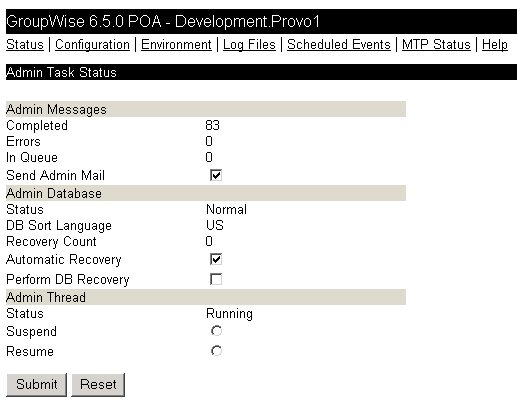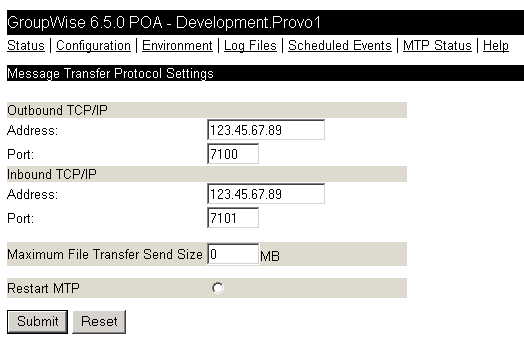Using the POA Web Console
The POA Web console enables you to monitor and control the POA from any location where you have access to a Web browser and the Internet. This provides substantially more flexible access than the POA agent console, which can only be accessed from the server where the POA is running.
- Setting Up the POA Web Console
- Accessing the POA Web Console
- Monitoring the POA from the POA Web Console
- Controlling the POA from the POA Web Console
Setting Up the POA Web Console
The default HTTP port for the POA Web console is established during POA installation. You can change the port number and increase security after installation in ConsoleOne.
-
In ConsoleOne, browse to and right-click the POA object, then click Properties.
-
Click GroupWise > Network Address to display the Network Address page.
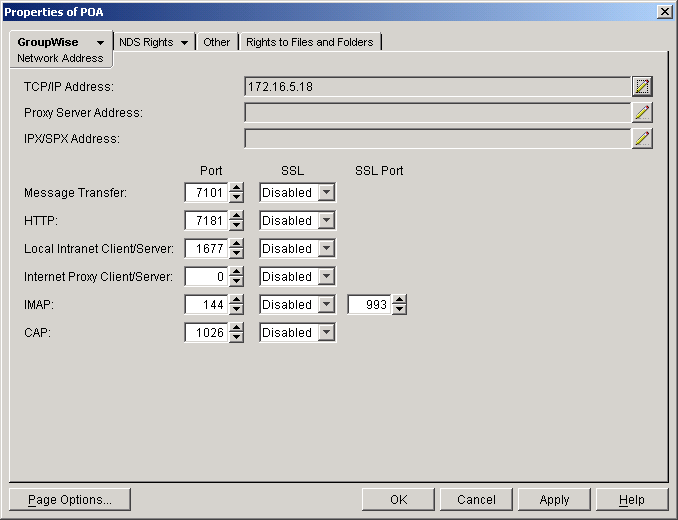
If you configured the POA for TCP/IP links during installation, the TCP/IP Address field should display the POA server's network address. If it does not, follow the instructions in Using TCP/IP Links between the Post Office and the Domain. The POA must be configured for TCP/IP in order to provide the POA Web console.
-
Make a note of the IP address or DNS hostname in the TCP/IP Address field. You need this information to access the POA Web console.
The HTTP Port field displays the default port number of 7181.
-
If the default HTTP port number is already in use on the POA server, specify a unique port number.
-
Make a note of the HTTP port number. You need this information to access the POA Web console.
-
If you want to use an SSL connection for the POA Web console, select Enabled in the HTTP SSL drop-down list.
For additional instructions about using SSL connections, see Encryption and Certificates.
-
Click Apply to save your changes on the Network Address page.
If you want to limit access to the POA Web console, you can provide a username and password.
-
Click GroupWise > Agent Settings, then scroll down to HTTP Settings.
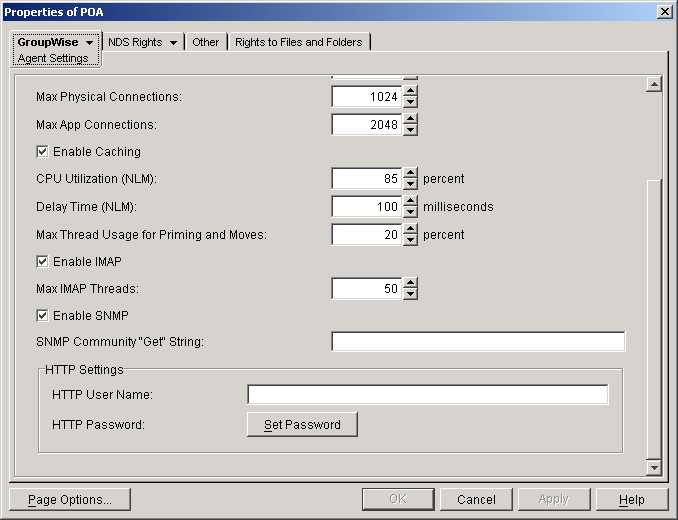
-
In the HTTP Settings box:
-
In the HTTP User Name field, specify a unique username.
-
Click Set Password.
-
Type the password twice for verification.
-
Click Set Password.
Unless you are using an SSL connection, do not use Novell® eDirectoryTM username and password because the information passes over the insecure connection between your Web browser and the POA.
For convenience, use the same username and password for all agents that you plan to monitor from GroupWise Monitor. This saves you from having to provide the username and password information as Monitor accesses each agent.
-
-
Click OK to save the POA Web console settings.
ConsoleOne then notifies the POA to restart so the new settings can be put into effect.
Corresponding Startup Switches
You could also use the /httpport, /httpuser, /httppassword, and /httpssl startup switches in the POA startup file to enable and secure the POA Web console. In addition, you can use the /httprefresh switch to control how often the POA refreshes the information provided to your Web browser.
Accessing the POA Web Console
To monitor the POA from your Web browser, view the POA Web console by supplying the network address and port number as displayed on the Network Address page in ConsoleOne. For example:
http://172.16.5.18:1677
http://172.16.5.18:7181
http://server1:7181
https://server2:1677
When viewing the POA Web console, you can specify either the client/server port or the HTTP port.
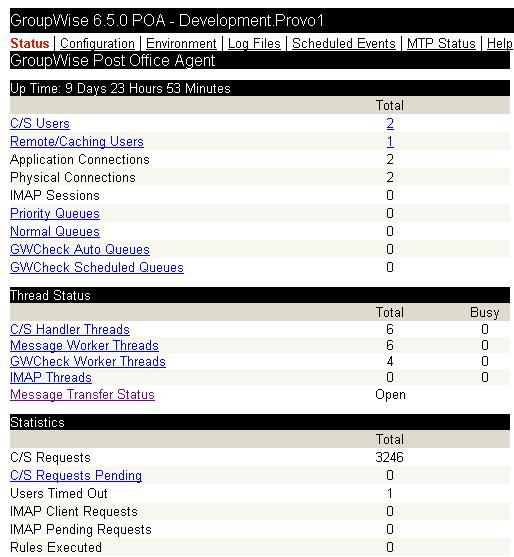
Monitoring the POA from the POA Web Console
The POA Web console provides several pages of information to help you monitor the performance of the POA. The bar at the top of the POA Web console displays the name of the POA and its post office. Below this bar appears the POA Web console menu that lists the pages of information available in the POA Web console. Online help throughout the POA Web console helps you interpret the information being displayed and use the links provided.
- Monitoring POA Status
- Checking the POA Operating System Environment
- Viewing and Searching POA Log Files
- Listing POA Scheduled Events
- Checking Link Status to the MTA
Monitoring POA Status
When you first access the POA Web console, the Status page is displayed. Online help on the Status page helps you interpret the status information being displayed.

Click any hyperlinked status items for additional details. The status information is much the same as that provided at the POA agent console, as described in Monitoring the POA from the POA Agent Console.
Checking the POA Operating System Environment
On the POA Web console menu, click Environment to display information about the operating system where the POA is running. On a NetWare server, the following information is displayed:
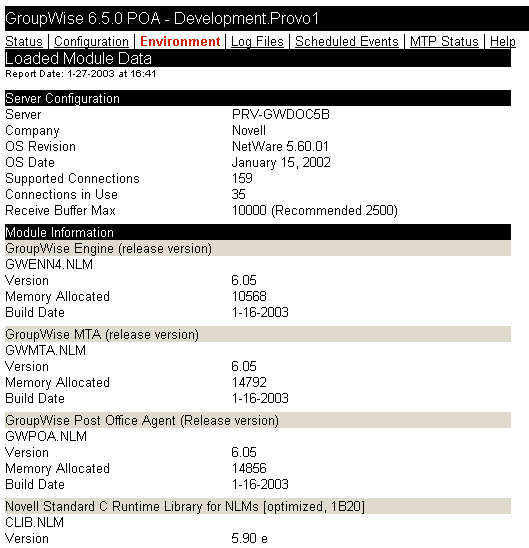
On a Linux server, the following information is displayed:
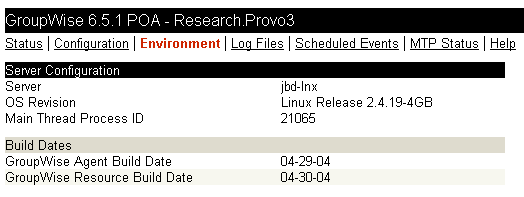
On a Windows server, the following information is displayed:
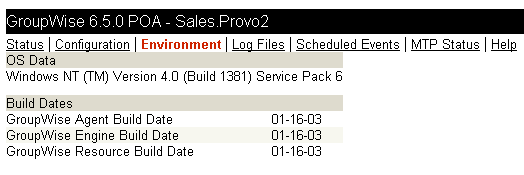
Viewing and Searching POA Log Files
On the POA Web console menu, click Log Files to display and search POA log files.
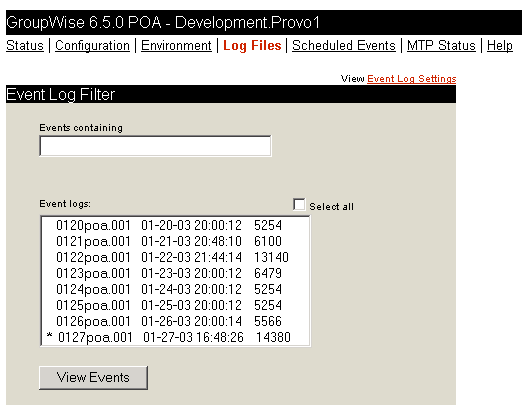
To view a particular log file, select the log file, then click View Events.
To search all log files for a particular string, type the string in the Events Containing field, select Select All, then click View Events. You can also manually select multiple log files to search.
The results of the search are displayed on a separate page which can be printed.
Listing POA Scheduled Events
On the POA Web console menu, click Scheduled Events to view currently scheduled events and their status information.
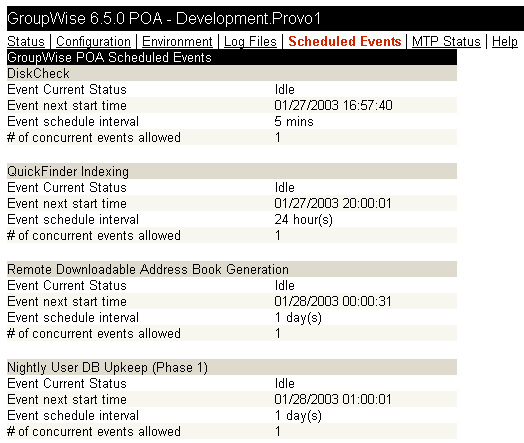
QuickFinder indexing and remote downloadable Address Book generation can be controlled using links from the Configuration page. The Configuration page also displays information about disk check events and database maintenance events. However, scheduled events must be created and modified using ConsoleOne.
Checking Link Status to the MTA
On the POA Web console menu, click MTP Status to view status information about the link between the POA for the post office and MTA for the domain.
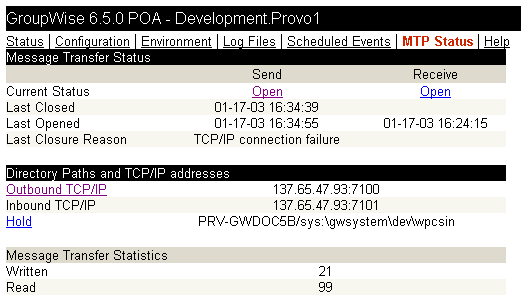
The Outbound TCP/IP link displays the MTA Web console where you can get status information about the MTA. The Hold link displays the contents of the MTA input queue, so you can find out if messages are waiting for processing by the MTA.
Controlling the POA from the POA Web Console
At the POA Web console, you can change some POA configuration settings for the current POA session. You can also stop and start some specific POA threads.
- Changing POA Configuration Settings
- Controlling the POA Admin Thread
- Controlling the POA MTP Threads
Changing POA Configuration Settings
On the POA Web console menu, click Configuration. Online help on the Configuration page helps you interpret the configuration information being displayed.
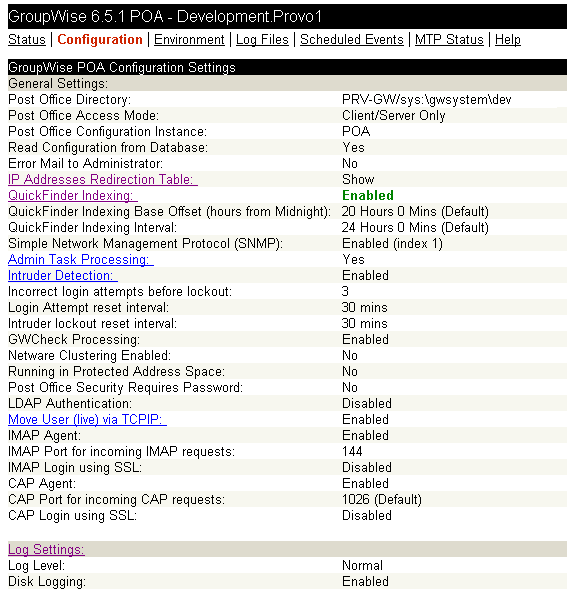
Click any hyperlinked configuration items to change settings for the current agent session. The settings that can be modified are much the same as those that can be changed at the POA agent console, as described in Controlling the POA from the POA Agent Console.
